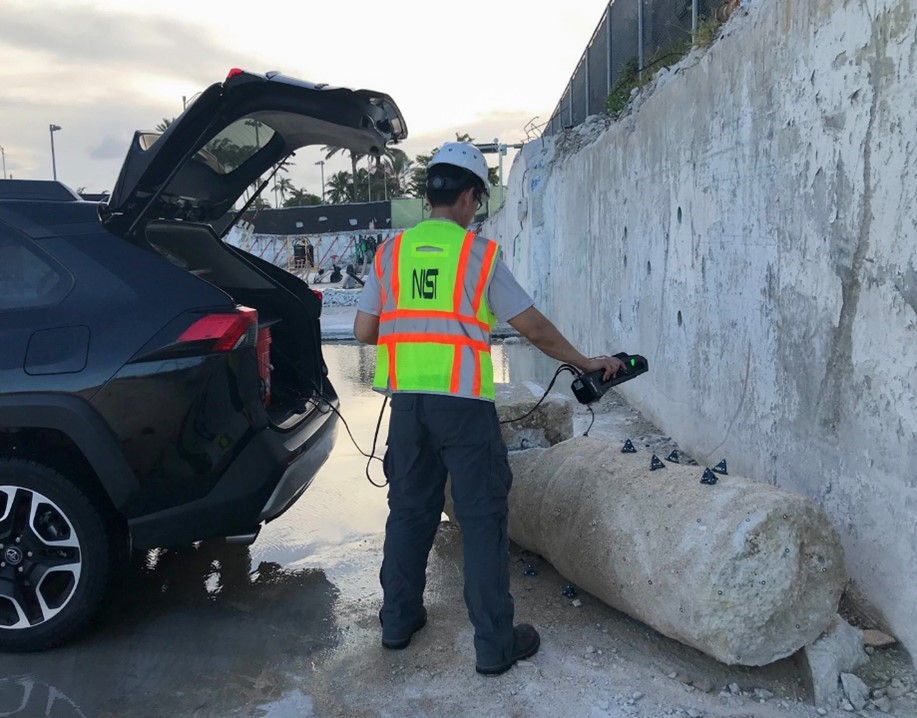Sept. 29, 2022, Update: Champlain Towers South Investigation Completes Site Testing, Announces Next Advisory Committee Meeting

The Thumper, a mini “mobile shaker,” custom-built at the University of Texas at Austin, sent waves of specific frequencies into the ground at the site of the former Champlain Towers South building in Surfside, Florida. Underground and surface sensors pick up the signals sent from the truck, and the data reveal information about ground characteristics.
This summer, members of the National Construction Safety Team (NCST) completed testing at the former site of the Champlain Towers South building in Surfside, Florida, collecting data to help improve computer models that will be used to evaluate potential causes of the June 2021 collapse. An update on this effort and other work related to the investigation will be presented to the NCST Advisory Committee at a public meeting on Oct. 19, 2022.
Following the resolution of civil litigation related to the tragedy, in July 2022 a Miami-Dade County Circuit Court judge ordered the turnover to NIST of materials and samples collected by the civil litigants, and data and information derived from those materials and samples.
“After reviewing these materials, we decided to collect additional data from the collapse site that would reduce uncertainties in our models, and we identified the most appropriate tests we would need to conduct,” said Judith Mitrani-Reiser, co-lead of the investigation. “We were able to leverage incredible resources and expertise through our interagency agreements with the National Science Foundation and the U.S. Army Corps of Engineers.”
The National Science Foundation’s Natural Hazards Engineering Research Infrastructure at the University of Texas at Austin (NHERI@UTexas), in collaboration with researchers at Utah State University, contributed a specialized truck designed to shake the ground at specific frequencies. Nicknamed the Thumper, the mini “mobile shaker” or, technically, “urban vibroseis,” created underground waves in designated parts of the site.
“The technology we used has been developed and applied primarily for earthquake research, so a building failure investigation is a novel application,” said Sissy Nikolaou, co-leader of the investigation’s geotechnical engineering project. “We were able to bring together multiple types of cutting-edge technology to better comprehend the ground behavior at different depths. This will help us understand how the Champlain Towers South site conditions may have been impacted over time.”

The team used custom-built vibration sensors and pushed them into the ground to measure wave propagation, or how the waves moved through and were diminished (attenuated) by the soil layers. With a unique configuration of sensors that formed a square, the researchers were able to “see” how the waves traveled through the site’s subsurface soils over relatively short distances and determine soil characteristics.
The data can help investigators determine how the structure may have interacted with the soil and foundations beneath it, which may in turn have affected how it would have responded to various loads or stresses. This data will also help researchers improve the accuracy of computer models created to describe the building and the site as they evolved over time and their condition at the time of collapse.
The team, including experts from the Georgia Institute of Technology, created high-resolution 3D images of the sections of foundation piles — long columns of concrete and steel — that were extracted from the site by the civil litigants’ experts.

In addition to the efforts at the collapse site, the team completed an inventory of specimens collected from the collapse site by the civil litigants. To ensure the chain of custody was preserved, the transfer of those specimens was formally documented with an independent consultant employed by the civil litigants.
The materials have been preserved in a secure location in Miami-Dade County, under 24-hour surveillance, where they have been carefully measured and catalogued.
NIST has begun the careful extraction of core samples of some of the evidence so that it can begin laboratory analysis and further inform computer models.
NIST will present an update on the investigation in a public meeting before the National Construction Safety Team Advisory Committee on Oct. 19, 2022. Those wishing to attend the meeting in person in Gaithersburg, Maryland, or virtually must register by following the instructions in the Federal Register announcement. Attendees may register to provide comments to the committee. The registration deadline is 5 p.m. Eastern time, Oct. 3, 2022.

